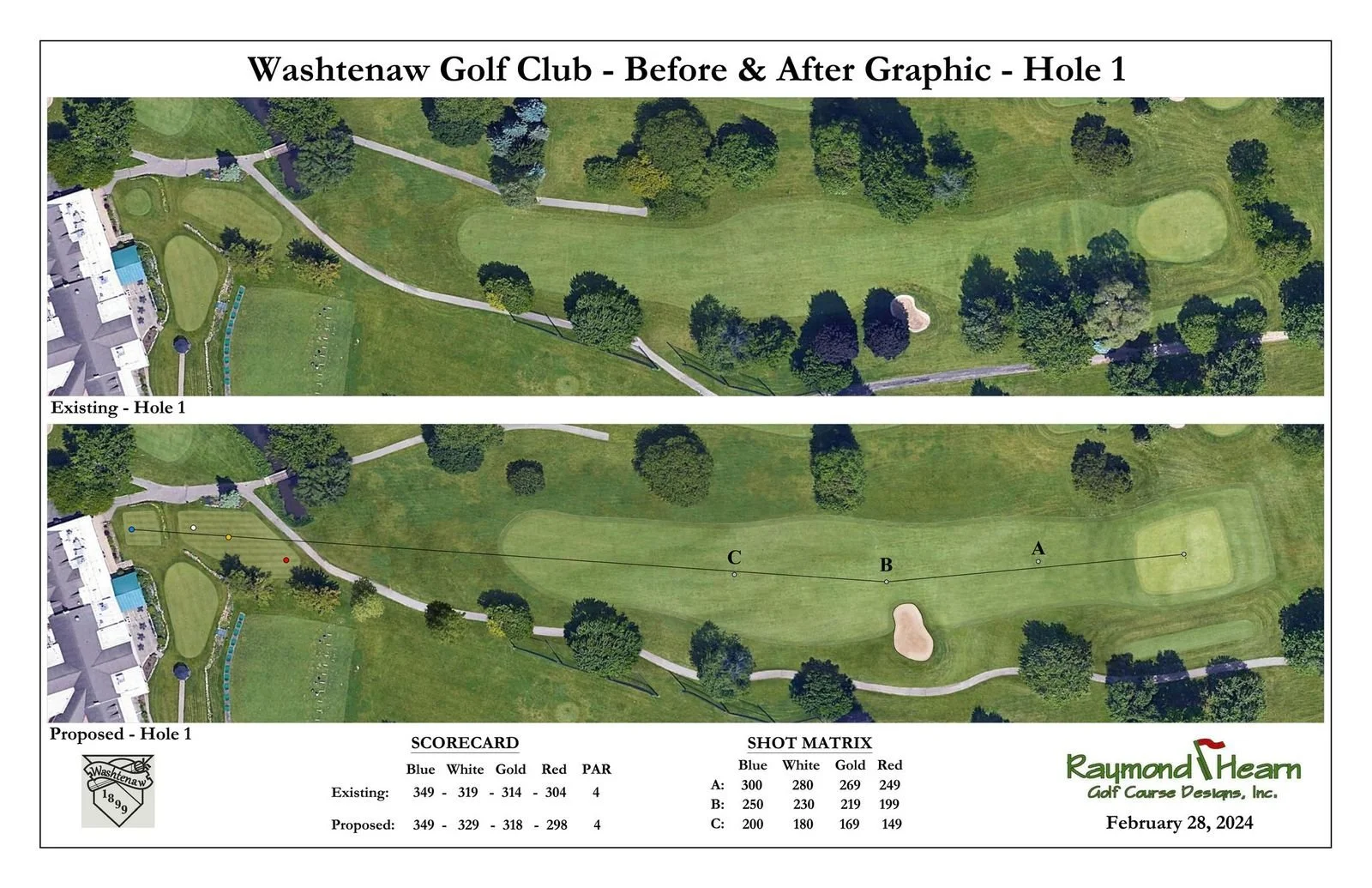Historic Greens – What do with them?
A golf course architect’s perspective
By Raymond Hearn, ASGCA
Historic greens are complex in design and intent, and must be thought of as independent entities functionally, while also coexisting with other features in order to provide unity, variety, strategy, shot value, beauty and playability on any golf hole. Entire books have been written about this topic.
So, how do golf properties evaluate historic greens? A good starting point is to review all aspects of your club’s greens, collars and approaches, especially at courses that suffer from limited cupping areas, chronic turf loss due to green settling, traffic wear areas, internal layering of organic matter or slopes that simply do not work with a desired modern day green speed.
While the course routing is the foundation for any golf course design, the green complex is the heart and soul of each golf hole.
Great green complexes often make you want to join a private club or return and play a public golf course over and over again. During the Golden Age of golf course design (mainly 1910 - 1937), many golf architects of that era were respected for their ability to design great course routings that fit into natural landscapes which included great natural green complexes. Ask 20 golf course designers for their list of favorite Golden Age golf course architects and you may get 20 different answers. Personally, I love the work of Donald Ross, Tom Bendelow, A.W. Tillinghast, Seth Raynor, Willie Park Jr., and Dr. Alister MacKenzie. I have studied their work extensively throughout my career.
When considering green restoration, I discuss numerous variables and objectives with boards, committees, superintendents, and golf professionals. Each club has a targeted green speed. I would say the preferred average is in between 10 and 12 on the stimpmeter. I like to see ‘Cupping,’ or ‘Pinnable Areas’ which have slopes between 0.5 - 3.5 percent that are essential to ensuring enjoyable and fair putting experiences. Green contours of 4 to 7 percent create great transition areas between “Cupping” areas while contours of 7 to 10 percent create dramatic accents. Green contours over 10 percent typically equal mowing problems and / or scalping.
In my 25-plus years as a practicing golf course architect, I estimate that seven of 10 courses I have played, visited, or consulted with have shown some symptoms of an improper relationship between existing green contours and desired green speed. This is especially true of historic golf courses where the greens were built before 1940. The complexity and severity of the dilemma can vary greatly, but its nature is fundamentally the same in that the green no longer ‘works’ because the precipitous slope was never intended to be combined with today’s green speeds of roughly 10 – 12 or above, as measured by a stimpmeter.
Many historic green complexes once were mowed and otherwise maintained to generate speeds of 5 – 6 are now being maintained at a green speed of 10 - 13.
Today, many golf course superintendents find themselves in a bind acceding to customer preference with historic greens (members in the case of private clubs, patrons at resorts and other public facilities). Striking a harmonious balance of green contours and desired green speed is impossible without some sort of remedial action. Do not despair, with a thorough inventory, analysis, design development and creative green restoration modern day green speeds can be harmonized with adjusted historic contours even at clubs where decreasing green speed through cultural practices is not an option.
In historic green design, I like the genius of the Golden Age golf course architects listed above in the transition areas they created on greens from one pinnable area to the next pinnable area. Modern day transition areas on greens are now typically between 4 – 7 percent slope. Slopes of 7 to 10 percent tend to decrease the golfer’s ability to negotiate these transitions due to the increase in putting challenge.
MacKenzie (of Augusta National fame) was brilliant in terms of integrating slopes from features surrounding the green and bringing them into the green at 5 to 15 percent slopes. Remember though, that the mowing height of greens and green speed in Dr. MacKenzie’s day was much slower than the green speed we commonly see on today’s courses. In between these bold contours flowing into MacKenzie’s greens, the ‘Good Doctor’ still created an abundance of 1 to 5 percent slopes for reasonable cupping areas in his era. Slope contours of 0.5 – 3.5 percent cupping areas work best with today’s desired, faster green speeds.
In the gallery at the bottom of the page is a great tool (shown with the greens and reds) I use in helping public and private clubs understand green slope problems as well as the solutions to correct them while still respecting the original architect’s design intent. The example shows a historic Donald Ross original green (No. 12) that once worked well at the green speed of 5 to 6 back in 1920s. In this case, the original design intent can be restored while allowing the new contours to work with modern day green of 10 - 11 as measured with a stimpmeter.
Green Surrounds
Nobody designed green surrounds better than Ross and MacKenzie. These types of areas can be mowed today at fairway height. Golfers have a choice of putting, lobbing or chipping their recovery shot back onto the green if they go astray. I tell many that green surround recovery options are just ‘good golf’ as they make the golfer think. Those of you who have enjoyed the good fortune of experiencing these wonderful areas around the greens on some of the great courses found in the British Isles, or on some of the older historic golf venues in the USA will appreciate what I am taking about.
I am sad to report that these wonderful areas around greens are disappearing on many U.S. Parkland-Style golf courses that have aggressive tree addition programs in place. Many unknowing board and committee members feel compelled to surround greens with trees to the point that there is no room around the greens for the wonderful variety of recovery options described above.
In the example of the Washtenaw Golf Club Hole 1 before and after images, we restored the green surrounds to the original surrounds and old green corners found on a 1930 aerial at the historic Washtenaw Golf Club in Ypsilanti, MI founded in 1899.
From this same 1930 aerial, we discovered lost cupping areas in the back right and left corners of the green that warranted a restoration discussion with the course’s managing owner and legendary Michigan Golf Hall of Fame member Mr. Dave Kendall. After soil probing, I was further able to justify these old green corners found on the historic aerial. The slopes in these two corners were approximately 2.5 percent and thus would make for particularly good modern day cupping areas.
Mr. Mark Pappas, Washtenaw’s talented golf course superintendent, worked with Dave and I to slowly bring these historic cupping areas back to life after a two-year period of careful cultural practices which included scalping, aerating, aggressive topdressing and overseeding. We overseeded with a Poa / Bent seed mixture needed to match the existing mottled but glorious old grasses found throughout the existing green.
The image from White Lake GC shows hole No. 16 green’s restoration at the historic west Michigan club in Whitehall, a 1916 Tom Bendelow design. The green and collar have now been restored to a 1925 aerial image secured from Michigan State University.
Today, modern day golf course architects have so many analytical tools at their disposal such as historic aerials, before and after slope analysis software, 3D modeling, before and after photo and plan imaging, etc. to make the decisions and the process a fun and meaningful journey for club and staff members.
The author Raymond Hearn is veteran golf course architect and president of Raymond Hearn Golf Course Designs, Inc. located in Holland, Michigan. Additional information on his restoration and renovation design process can be found on his web site at www.rhgd.com.




